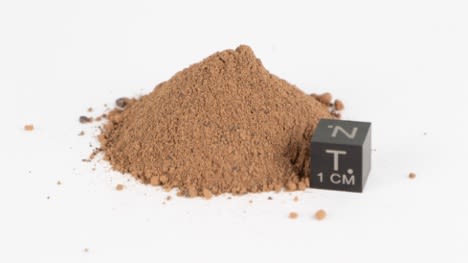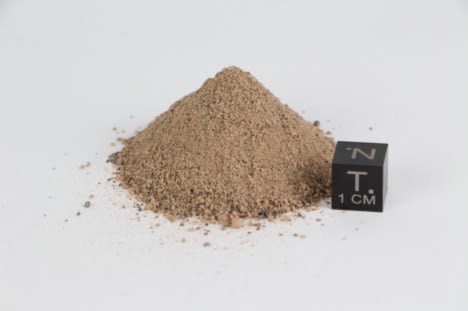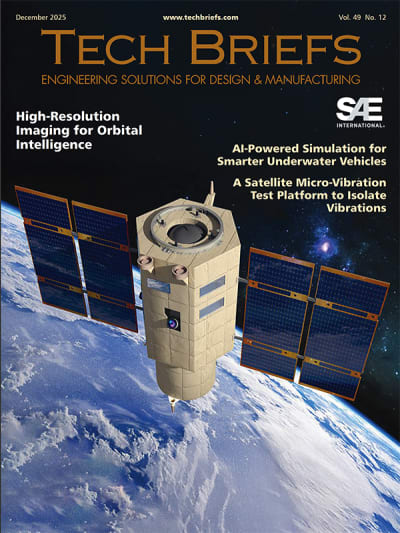
Exploring and developing permanent infrastructure on Mars requires the development of technologies to enable safe and efficient operations, from landing, roving, and extravehicular activities (EVAs) to prospecting, evaluating, acquiring, extracting, and utilizing local resources. Martian regolith is likely to be the main resource used for initial Martian in situ resource utilization (ISRU) to lessen the amount of resources and supplies that must be launched at high cost from Earth and take up precious cargo space.
The physical properties of Martian regolith are drastically different from of terrestrial soils and regolith, owing to the different atmospheric conditions and geologic history as well as the different rock and regolith mineralogy, so technologies that are intended to use or interact with the Martian regolith must be tested with appropriate simulated regolith, or simulants. For realistic results it is critical for Martian regolith analogs to suitably approximate the geomechanical, geophysical, thermophysical, and geochemical properties of the Martian regolith.
The Center for Lunar and Asteroid Surface Science (CLASS) node of the NASA Solar System Exploration Research Virtual Institute (SSERVI) established non-profit Exolith Lab at the University of Central Florida (UCF) to develop and distribute bulk amounts of standardized high-fidelity Martian, lunar, and asteroid regolith simulants for the planetary science and engineering communities.
The design philosophy behind Exolith Lab regolith simulants is a constrained maximization of fidelity relative to cost, safety, and product availability that prioritizes accuracy in mineralogy and particle size distribution. Particle size distribution is well known to affect the physical properties of granular geologic media (such as Martian regolith) and significantly impact trafficability, excavation, and thermal and chemical processing, but mineralogic composition has largely been ignored in past simulants such as cocoa shells and beach sand as well as the basaltic MMS and JSC Mars-1 simulants.
The mineralogy of regolith, soils, and rocks determines the particle geometry, grain density, and bulk chemical composition of the regolith, all of which impact both the net physical and chemical properties of the aggregate, and failure to understand the properties of Martian regolith has resulted in several mission failures from organizations around the globe. Exolith Lab’s design philosophy fills the gap left by previous Martian regolith simulants by providing realistic materials with which to test a range of technologies for Martian surface interactions and operations.
Mineral Sourcing and Mixing

Exolith Lab Martian regolith simulants are based on published findings from remote sensing data and landed instruments to estimate the mineralogy of the Martian regolith. Once the desired mineralogy is determined, high purity rocks and minerals that are similar in composition to the Martian regolith are sourced and percussively crushed to appropriate particle size distributions (based on imagery and remote sensing) using industry standard mining and rock processing equipment such as hammer mills and jaw crushers followed by mixing appropriate proportions of individual mineral components into the final simulants.
The piecewise approach of mineral sourcing and mixing allows for more customization of simulants compared to past simulants which used one homogenous material with no possibility of varying composition to cater to specific testing needs or to accommodate natural variations in geology at different sites of interest on the Martian surface.
Exolith Lab produces four Martian regolith simulants that are intended to offer a wide but realistic range of compositions to mimic different regions on the geologically complex Martian surface, namely MGS-1, MGS-1C, MGS-1S, and JEZ-1. The mass-based mineralogical compositions of each of these simulants is given in Table 1.

Accurate Test Materials


Martian Global Simulant, MGS-1 (Figure 1), is based on data returned by NASA’s Curiosity rover at the Rocknest site in Gale crater. Rocknest is the most well-characterized material on the Martian surface and has a basaltic composition that is observed at other landing sites, indicating that Mars has a globally basaltic crust that is being processed into regolith by impacts, active eolian, and ancient fluvial processes.
Since MGS-1 simulates the average composition of Martian regolith and geology is known to vary laterally and vertically as driven by site-specific alteration processes (e.g., wind, water, impacts), MGS-1 is used as the base of the other three Exolith Lab Martian regolith simulants: MGS-1C (Figure 2), MGS-1S (Figure 3), and JEZ-1 (Figure 4). MGS-1C is a modified version of MGS-1 with a significant enrichment in clay, which is reflective of a clay-rich Martian regolith like that found in the Noachian terrane near the Hellas impact basin.


MGS-1C is suitable for testing technologies that will interact with clay-rich Martian regolith since clays have unique, self-lubricating mechanical properties and complex chemical compositions. MGS-1S, just like MGS-1C, is a modified version of MGS-1 that is enriched in sulfates as would be expected to be encountered in areas on Mars that experienced hydrothermal activity and is well suited for the research and development of technologies for sulfate mining or volatile extractions.
JEZ-1 is the Exolith Lab simulant designed to simulate the regolith in Mars’ Jezero delta, which is being sampled and returned to Earth as part of NASA’s Mars Sample Return mission.
Exolith Lab Martian regolith simulants can be used to test a myriad of technologies, from rovers, scientific instruments, autonomous and crewed landing systems, resource extraction, and infrastructure development. When designing and testing rover wheels, it is critical to use accurate test materials since the terramechanical properties of Martian regolith are vastly different than anything found on Earth. Failure to use appropriate analog materials will not give an accurate representation of rover wheel interactions (e.g., slip and sinkage), drive mechanics, seal and gasket performance, and abrasion.
Landing on Mars
Landings on planetary surfaces are high-speed and high-energy events. How the landing system interacts with the surface (e.g., rocket plumes) determines the velocities and trajectories of particles ejected from the surface, often at supersonic speeds, which can travel long distances and nearby damage equipment. Having landing systems tested in realistic materials gives a better idea of what can be expected when landing on Mars in terms of abrasion and plume surface interactions, and inappropriate simulants will give results that are not reflective of what can be expected from the Martian surface.
For Mars exploration instruments, it is critical to use proper regolith testing materials or risk a misunderstanding of the properties of the regolith being investigated causing failures such as seen in the Mole on NASA’s InSight mission. Since infrastructure development (e.g., roadways, buildings, berms) is often of sufficient scale to affect large areas of the surface and subsurface on Earth, the same can be expected for Mars, so an understanding of key, site-specific geotechnical properties such as settlement and elastic moduli must be had to enable safe and reliable construction efforts on Mars.
This article was written by Jared Long-Fox, Planetary Exploration Research Scientist, Department of Physics and Daniel Britt, Pegasus Professor, Department of Physics, both at the University of Central Florida. For more information, visit here .
Transcript
No transcript is available for this video.

